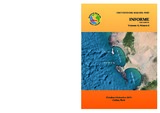Por favor, use este identificador para citar o enlazar este ítem:
https://hdl.handle.net/20.500.12958/2998Registro completo de metadatos
| Campo DC | Valor | Lengua/Idioma |
|---|---|---|
| dc.contributor.author | Flores Castillo, Daniel | - |
| dc.contributor.author | Zavala Huambachano, José | - |
| dc.contributor.author | Donayre Salazar, Susan | - |
| dc.contributor.author | Guardia Otárola, Alex | - |
| dc.contributor.author | Sarmiento Bendezú, Héctor | - |
| dc.date.accessioned | 2016-03-29T20:03:44Z | - |
| dc.date.available | 2016-03-29T20:03:44Z | - |
| dc.date.issued | 2015 | - |
| dc.identifier.citation | Inf Inst Mar Perú 42(4), 2015. p. 504-509 | es_ES |
| dc.identifier.uri | https://hdl.handle.net/20.500.12958/2998 | - |
| dc.description | Informe IMARPE;Vol. 42, N° 4, 2015 p.504-509 | es_ES |
| dc.description.abstract | Entre mayo y junio 2010, se desarrolló la evaluación poblacional de la macroalga Chondracanthus chamissoi “yuyo” de las praderas en las bahías de Pisco y Paracas. Las biomasas medias fluctuaron entre 2,2 y 67,0 g.m-2, con promedio de 43,6 g.m-2. Se estimó una biomasa total de 211,96 toneladas (±56,8%); de los cuales 179,74 t correspondieron a Atenas; 30,1 t a Puerto Nuevo y 2,1 t a Playa Lobería. El sustrato de fijación estuvo compuesto, principalmente, por piedras, conchuela y arena media. En las praderas de Atenas ocupó la mayor parte del área evaluada, en las praderas de Puerto Nuevo y Playa Lobería se encontraron reducidas, respecto al 2007. Se encontró ejemplares entre 1 y 25 cm de longitud. El peso total individual varió de 0,1 a 94,6 g. Se registró biodiversidad asociada conformada por moluscos. Las condiciones oceanográficas se registraron normales, lo que permite suponer que la disminución poblacional respondería a las actividades de extracción. | es_ES |
| dc.description.abstract | ABSTRACT: Between May and June 2010 the population assessment of macroalgae Chondracanthus chamissoi in the bays of Pisco and Paracas was developed. The mean biomass fluctuated between 2.2 and 67.0 gm-2, with an average of 43.6 gm-2. A total biomass of 211.96 tons (±56.8%) was estimated; of which 179.74 t corresponded to Atenas; Puerto Nuevo 30.1 t and 2.1 t Playa Lobería. The attachment substrate consisted mainly of stones, sand and crushed shells. In Atenas meadows he occupied most of the area evaluated, in the grasslands of Puerto Nuevo and Playa Lobería they found reduced, compared to 2007. We found samples from 1 to 25 cm in length. The total individual weight ranged from 0.1 to 94.6 g. Was recorded associated biodiversity consists of mollusks. Oceanographic conditions recorded normal, which suggests that the population decline to answer extraction activities. | - |
| dc.description.sponsorship | Instituto del Mar del Perú | es_ES |
| dc.language.iso | spa | es_ES |
| dc.publisher | Callao | es_ES |
| dc.relation.ispartofseries | Informe IMARPE;Vol. 42, N° 4, 2015 | - |
| dc.rights | info:eu-repo/semantics/openAccess | es_ES |
| dc.rights.uri | https://creativecommons.org/licenses/by/4.0/ | - |
| dc.source | Instituto del Mar del Perú - IMARPE | es_ES |
| dc.source.uri | Repositorio Digital IMARPE | es_ES |
| dc.subject | Chondracanthus Chamissoi | es_ES |
| dc.subject | Macroalgas | es_ES |
| dc.subject | Población | es_ES |
| dc.subject | Biomasa | es_ES |
| dc.title | Evaluación poblacional de Chondracanthus chamissoi (C. Agardh 1820) en las bahías de Pisco y Paracas, Otoño 2010. | es_ES |
| dc.title.alternative | Population assessment Chondracanthus chamissoi (C. Agardh 1820) in the bays Pisco and Paracas, autumn 2010 | es_ES |
| dc.type | info:eu-repo/semantics/article | es_ES |
| Aparece en las colecciones: | Informe vol. 42(4) 2015 | |
Ficheros en este ítem:
| Fichero | Descripción | Tamaño | Formato | |
|---|---|---|---|---|
| Informe 42(4)-8.pdf | 1,45 MB | Adobe PDF |  Visualizar/Abrir |
Este ítem está sujeto a una licencia Creative Commons Licencia Creative Commons

